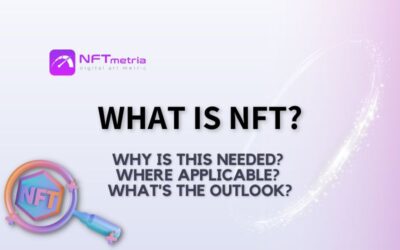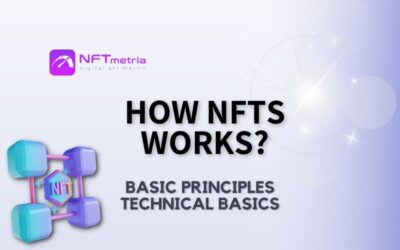In an era where sharing photos online often means surrendering your rights to social media giants, the advent of Non-Fungible Tokens (NFTs) brings a transformative solution. These unique digital assets, represented on the blockchain, empower individuals to claim true ownership of their online creations, safeguarding them from the clutches of platform ownership.
The surge in NFT adoption speaks volumes:
- In 2020, 75,000 NFT buyers populated the market; by 2021, a staggering 2.3 million buyers had embraced this innovative concept.
- Market volume surged from $100 million in 2020 to an astounding $30 billion in 2021.
This article aims to unravel the essence of NFTs and explore the driving factors behind their meteoric rise. Let’s embark on a journey to understand NFTs in their simplest form and unveil the secrets behind their widespread acclaim.
What Are NFTs?
NFTs, or Non-Fungible Tokens, are a type of digital asset that represent ownership or proof of authenticity of a unique item or piece of content using blockchain technology. Unlike cryptocurrencies such as Bitcoin or Ethereum, NFTs are indivisible and cannot be exchanged on a one-to-one basis because each one has distinct characteristics that set it apart from others.
NFTs have garnered significant attention in various fields, from art and music to gaming and entertainment, as they enable creators and artists to sell their digital creations as one-of-a-kind items. NFTs also have a wide range of potential applications, such as proving ownership of virtual real estate, unique collectibles, and even access to exclusive content or experiences.
One of the core features of NFTs is their uniqueness and immutability, making them attractive to collectors and enthusiasts. They are stored on a blockchain, which ensures the transparency and traceability of ownership. This has created a new way for creators and content producers to monetize their work, and NFTs have become a prominent aspect of the digital economy, with sales and transactions happening on various NFT marketplaces.
Why are NFTs popular?
Non-Fungible Tokens emerged in 2017, gaining widespread popularity in 2020-2021, primarily due to the blockchain technology, especially Ethereum. Ethereum enables the creation of unique tokens through the ERC-721 standard, defining the structure and functions of non-fungible tokens.
Initially, NFTs drew attention in the online gaming industry. One of the first successful projects was CryptoKitties, developed by Dapper Labs on the Ethereum platform in 2017. This game allowed users to create, collect, and breed unique digital kittens in the form of NFTs.
Over time, NFTs found applications in various fields such as art, music, games, sports, entertainment, real estate, virtual worlds, and even education. It’s crucial to note that this technology continues to evolve, attracting artists, musicians, investors, and collectors, opening new possibilities in the digital asset world.
The NFT market gained immense popularity, thanks to active participation from celebrities and influencers. Many well-known personalities began creating and selling their unique digital assets in the form of NFTs, capturing the attention of the public and mainstream culture.
For instance, musicians like Grimes and Kings of Leon released albums as NFTs, allowing fans to own unique audio recordings. Artists like Beeple sold their digital artworks at auctions for millions of dollars as NFTs. Basketball stars like LeBron James issued their collectible cards as NFTs, attracting sports memorabilia collectors.
Influencers also started creating and selling their exclusive content as NFTs, enabling their fans to acquire exclusive materials and support their favorite influencers.
These examples illustrate how celebrities and influencers actively engage in the NFT market, making it more captivating and appealing to a broader audience.
Where Are NFTs Used?
NFTs find applications in various domains, showcasing their versatility and expanding influence. Here are some key areas where NFTs are used:
- Digital Art: NFTs have revolutionized the art world, enabling digital artists to tokenize their creations. Artists can sell their digital artworks directly to buyers, ensuring provenance and authenticity through blockchain technology. For example, digital artist Beeple sold his NFT artwork “Everydays: The First 5000 Days” at a Christie’s auction for 69 million dollars, setting a record for digital art and NFTs.
- Gaming: In the gaming industry, NFTs are used to create unique in-game assets, characters, skins, and accessories. Players can buy, sell, and trade these items securely, giving rise to player-driven economies within games. For example, the game Axie Infinity allows players to earn NFT characters that they can sell and trade within the game. Some of these NFT characters have been sold for thousands of dollars.
- Collectibles: NFTs are widely used for creating digital collectibles, ranging from trading cards and stamps to virtual pets and rare items. Collectors can prove the rarity and ownership of these items on the blockchain. The NFT collectible card series “NBA Top Shot” enables fans to purchase moments from NBA games in the form of NFTs. One moment was sold for over $200,000.
- Music and Audio: Musicians and audio creators are utilizing NFTs to sell exclusive music albums, concert tickets, and audio clips. NFTs provide a new revenue stream for artists and enhance fan engagement. Musician 3LAU released his album “Ultraviolet” as an NFT, which was sold for $11 million. This NFT also provided additional bonuses such as VIP passes and exclusive tracks.
- Virtual Real Estate: Within virtual worlds and metaverse platforms, NFTs represent parcels of virtual land or property. Investors can buy, sell, and develop these digital assets, contributing to the virtual real estate market’s growth. In the Decentraland metaverse, users can buy land parcels as NFTs, which they can then use to create virtual stores, entertainment centers, and other facilities.
- Content Creation: Content creators, including writers, bloggers, and video producers, use NFTs to tokenize their content. Fans and followers can purchase exclusive access to articles, videos, or other digital content. For example, journalist and writer Alexia Matak created NFTs representing her articles and texts. Fans can purchase these NFTs to gain exclusive access to her works.
- Fashion and Apparel: Fashion brands are exploring NFTs to create digital fashion items and wearables. Customers can own limited-edition digital fashion pieces, which might also be wearable in virtual worlds and games. The brand Gucci released limited-edition digital sneakers as NFTs that buyers can wear in the Decentraland metaverse. But this, of course, is not the only luxury brand in the NFT world. NFTs in fashion are an extremely promising area, and you can read our special article about this.
- Ticketing and Events: NFTs are used for digital event tickets, ensuring their authenticity and preventing counterfeiting. Attendees can prove their ticket ownership through blockchain-based NFTs. The legendary music festival Burning Man uses NFTs to sell virtual tickets and passports, providing access to exclusive content during the event.
- Charity and Fundraising: Non-profit organizations leverage NFTs to raise funds and create unique digital collectibles for donors. The transparent nature of blockchain ensures that the proceeds go to the intended charitable causes. Musician Grimes created a digital artwork for an NFT, which was sold for $6 million, and all proceeds were donated to charitable causes.
- Education and Certifications: Educational institutions are exploring NFTs for issuing digital diplomas, certificates, and badges. NFTs can authenticate the educational achievements of individuals securely. Universities like the Massachusetts Institute of Technology (MIT) use NFTs to issue digital diplomas, providing students with unique blockchain-based identifiers.
These diverse applications showcase the adaptability of NFTs, transforming various industries and providing new opportunities for creators, collectors, and enthusiasts.
Why Are NFTs Needed?
Non-Fungible Tokens serve several crucial purposes in the digital world, making them highly sought after by NFT investors and enthusiasts alike.
- Ownership and Authenticity: NFTs provide a secure way to prove ownership and authenticity of digital assets, such as art, music, videos, and virtual items in games. Each NFT is unique and carries a distinct digital signature, ensuring its authenticity and origin.
- Digital Collectibles: NFTs enable the creation and trading of digital collectibles, allowing enthusiasts to own exclusive and rare items in the digital realm. This has transformed the concept of collecting, shifting it from physical to digital assets.
- Monetization for Creators: NFTs offer creators, artists, musicians, game developers, and other content producers a new revenue stream. By tokenizing their work, creators can sell their digital creations directly to consumers, bypassing intermediaries and retaining more control over their content and earnings.
- Smart Contracts and Royalties: NFTs operate on blockchain networks like Ethereum, enabling the use of smart contracts. These contracts can automatically execute actions, such as distributing royalties to creators every time their NFT is resold. This feature ensures that artists continue to benefit from the secondary market sales of their work.
- Decentralization and Ownership Control: NFTs empower individuals with true ownership and control over their digital assets. Unlike traditional digital files, which can be easily copied and shared, NFTs cannot be replicated, ensuring the uniqueness and value of each item.
- In-Game Assets: In the gaming industry, NFTs represent unique in-game assets, characters, skins, or items. Players can buy, sell, and trade these assets across games and platforms, creating a cross-game economy.
- Fan Engagement: NFTs allow celebrities, influencers, and brands to engage with their fans in innovative ways. By releasing limited edition NFTs or exclusive content, they can create a direct connection with their audience, offering unique and personalized experiences.
- Investment Attractiveness: NFTs have gained immense popularity among investors due to their potential for significant appreciation in value. Rare and sought-after NFTs, especially those associated with well-known artists or iconic moments, have become valuable assets in the growing digital art market, making them an attractive investment opportunity.
In summary, NFTs provide a revolutionary way to tokenize, trade, monetize digital assets, and offer investment attractiveness through their potential for value appreciation, making them a compelling choice for both creators and investors.
Challenges and Criticisms of NFTs
Certainly, NFTs come with their fair share of criticisms and challenges, but it’s essential to recognize that the market actively addresses these issues. In this regard, we not only highlight the challenges but also offer insights into potential solutions:
- Environmental Concerns
- Challenge: High energy consumption of blockchain networks, particularly Ethereum, used for NFT transactions.
- Counterargument: Researching and adopting eco-friendly blockchain alternatives with reduced carbon footprint.
- Solution: Development and promotion of energy-efficient blockchain technologies to mitigate environmental impact.
- Copyright and Intellectual Property Issues:
- Challenge: Copyright infringements and unauthorized duplication of digital assets sold as NFTs.
- Counterargument: Immutable blockchain ledgers provide transparent ownership records, aiding in copyright enforcement.
- Solution: Strengthening digital rights management systems and legal frameworks for protecting intellectual property rights in the digital realm.
- Market Saturation and Speculative Bubble:
- Challenge: Oversaturation of the NFT market, leading to potential devaluation of digital assets.
- Counterargument: Unique, high-quality content and celebrity endorsements sustain market demand.
- Solution: Emphasizing the value of rare and exclusive NFTs, encouraging creators to focus on quality rather than quantity.
- Inclusivity and Access Barriers:
- Challenge: Limited access to NFTs due to technical complexities and high entry costs.
- Counterargument: Growing popularity of user-friendly platforms and fractionalized ownership options.
- Solution: Promoting education and user-friendly interfaces, exploring decentralized finance (DeFi) solutions for affordable NFT investments.
- Environmental Impact of Digital Art Creation:
- Challenge: Carbon footprint associated with digital art creation, especially in resource-intensive processes.
- Counterargument: Advancements in eco-friendly digital art tools and techniques, raising awareness among artists.
- Solution: Encouraging sustainable art practices, supporting eco-conscious art tools, and advocating for carbon offset initiatives.
- Scalability and Blockchain Congestion:
- Challenge: Scalability issues causing congestion and high transaction fees during peak periods.
- Counterargument: Ongoing research on Layer 2 solutions and blockchain upgrades to enhance scalability.
- Solution: Implementing Layer 2 scaling solutions like rollups, exploring interoperability between blockchains for improved transaction throughput.
Addressing these challenges requires a collaborative effort from blockchain developers, artists, legal experts, and environmentalists to ensure the sustainable growth of the NFT ecosystem while mitigating its drawbacks.
Future Outlook of NFTs
As we gaze into the future of Non-Fungible Tokens, a landscape of infinite possibilities unfolds before us. The NFT space, already vibrant and transformative, is poised for unprecedented growth and evolution. In this section, we delve deep into the realm of tomorrow, exploring the potential, advancements, and revolutionary changes awaiting the NFT ecosystem.
Anticipating Technological Marvels
The future of NFTs is intricately intertwined with cutting-edge technologies. From augmented reality to virtual reality, the integration of NFTs into immersive experiences is on the horizon. Imagine a world where digital art not only adorns virtual galleries but also comes to life in interactive, three-dimensional spaces. With advancements in blockchain technology, faster transaction speeds and reduced energy consumption are on the cards, addressing current challenges and ensuring a seamless NFT experience.
Emerging Trends and Applications
The NFT landscape is constantly evolving, giving rise to innovative trends and applications. From the gamification of NFTs, where in-game assets are tokenized, to the utilization of NFTs in the real estate industry, where property deeds are securely stored on the blockchain, the applications are vast and varied. Moreover, educational institutions are exploring NFTs for digital certifications, ensuring the authenticity and immutability of academic achievements. NFTs are not merely collectibles; they are becoming the foundation of a decentralized digital economy.
The Role of NFTs in the Digital Age
In the ever-changing digital landscape, NFTs are set to play a pivotal role. They are not just digital assets; they represent ownership, creativity, and authenticity in the virtual realm. As the world embraces the metaverse, NFTs will become the cornerstone of digital identities and virtual interactions. Artists, musicians, gamers, and content creators will find solace in NFTs, as they empower creators and democratize the creative industry. Moreover, NFTs will redefine the concept of ownership, offering a tangible presence in the intangible world of the internet.
NFTs are more than tokens—they are gateways to unparalleled experiences, expressions, and innovations. Join us as we navigate the uncharted territories of the NFT landscape, unraveling the endless possibilities that await in the days to come.











